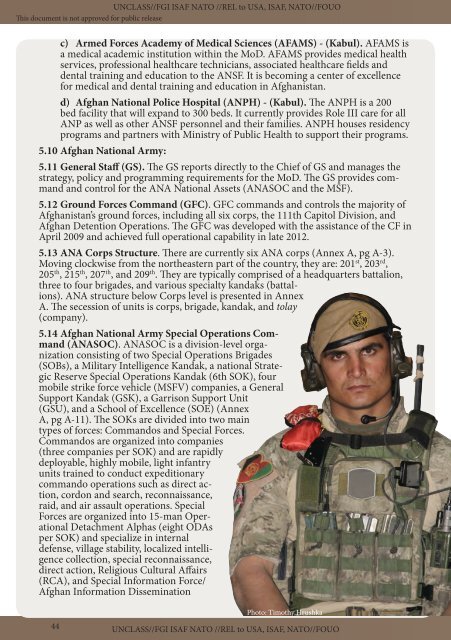20140927_NIU_CJ7_TREX_SFA guide 3.1
20140927_NIU_CJ7_TREX_SFA guide 3.1
20140927_NIU_CJ7_TREX_SFA guide 3.1
You also want an ePaper? Increase the reach of your titles
YUMPU automatically turns print PDFs into web optimized ePapers that Google loves.
UNCLASS//FGI ISAF NATO //REL to USA, ISAF, NATO//FOUO<br />
This document is not approved for public release<br />
c) Armed Forces Academy of Medical Sciences (AFAMS) - (Kabul). AFAMS is<br />
a medical academic institution within the MoD. AFAMS provides medical health<br />
services, professional healthcare technicians, associated healthcare fields and<br />
dental training and education to the ANSF. It is becoming a center of excellence<br />
for medical and dental training and education in Afghanistan.<br />
d) Afghan National Police Hospital (ANPH) - (Kabul). The ANPH is a 200<br />
bed facility that will expand to 300 beds. It currently provides Role III care for all<br />
ANP as well as other ANSF personnel and their families. ANPH houses residency<br />
programs and partners with Ministry of Public Health to support their programs.<br />
5.10 Afghan National Army:<br />
5.11 General Staff (GS). The GS reports directly to the Chief of GS and manages the<br />
strategy, policy and programming requirements for the MoD. The GS provides command<br />
and control for the ANA National Assets (ANASOC and the MSF).<br />
5.12 Ground Forces Command (GFC). GFC commands and controls the majority of<br />
Afghanistan’s ground forces, including all six corps, the 111th Capitol Division, and<br />
Afghan Detention Operations. The GFC was developed with the assistance of the CF in<br />
April 2009 and achieved full operational capability in late 2012.<br />
5.13 ANA Corps Structure. There are currently six ANA corps (Annex A, pg A-3).<br />
Moving clockwise from the northeastern part of the country, they are: 201 st , 203 rd ,<br />
205 th , 215 th , 207 th , and 209 th . They are typically comprised of a headquarters battalion,<br />
three to four brigades, and various specialty kandaks (battalions).<br />
ANA structure below Corps level is presented in Annex<br />
A. The secession of units is corps, brigade, kandak, and tolay<br />
(company).<br />
5.14 Afghan National Army Special Operations Command<br />
(ANASOC). ANASOC is a division-level organization<br />
consisting of two Special Operations Brigades<br />
(SOBs), a Military Intelligence Kandak, a national Strategic<br />
Reserve Special Operations Kandak (6th SOK), four<br />
mobile strike force vehicle (MSFV) companies, a General<br />
Support Kandak (GSK), a Garrison Support Unit<br />
(GSU), and a School of Excellence (SOE) (Annex<br />
A, pg A-11). The SOKs are divided into two main<br />
types of forces: Commandos and Special Forces.<br />
Commandos are organized into companies<br />
(three companies per SOK) and are rapidly<br />
deployable, highly mobile, light infantry<br />
units trained to conduct expeditionary<br />
commando operations such as direct action,<br />
cordon and search, reconnaissance,<br />
raid, and air assault operations. Special<br />
Forces are organized into 15-man Operational<br />
Detachment Alphas (eight ODAs<br />
per SOK) and specialize in internal<br />
defense, village stability, localized intelligence<br />
collection, special reconnaissance,<br />
direct action, Religious Cultural Affairs<br />
(RCA), and Special Information Force/<br />
Afghan Information Dissemination<br />
Photo: Timothy Hrushka<br />
44<br />
UNCLASS//FGI ISAF NATO //REL to USA, ISAF, NATO//FOUO


